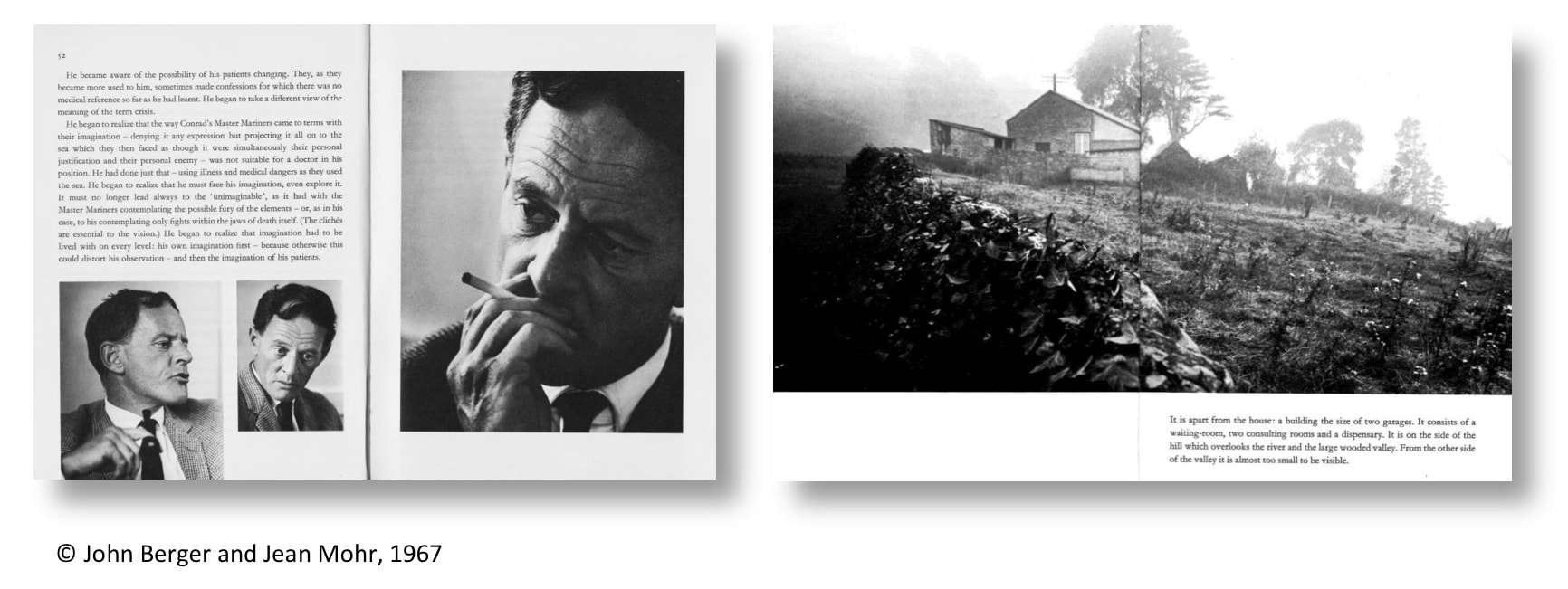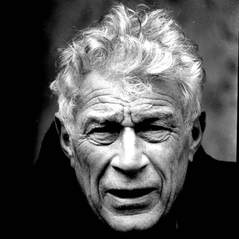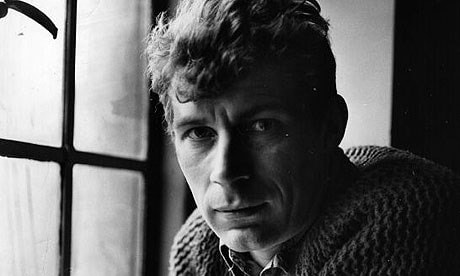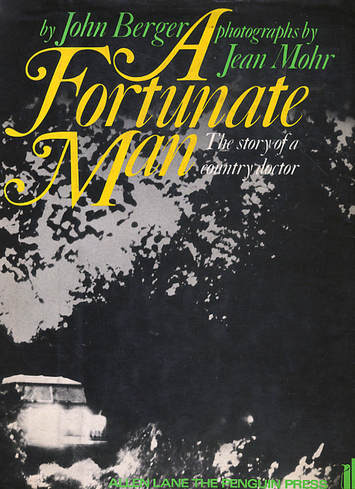john berger
|
1926 - 2017
Novelist, essayist, art critic, painter, campaigner and broadcaster, of international significance and renown. It was whilst living in the Forest of Dean that he got to know a St Briavels' GP. With documentary photographer Jean Mohr he created the book A Fortunate Man (1967) that became recognised as a seminal work on the GP-patient relationship, and the role of the doctor in a rural community. |
forest OF dEAN cONNECTION In 1955 Berger married his second wife, Rosemary Sibell Guest, (herself an author writing under the pen name Evelyn Jordan), daughter of 1st Viscount Wimborne, and recently divorced from Alistair Boyd 6th Baron Kilmarnock. It may have been Rosemary's eldest son, who had met John at an exhibition of his paintings, who first introduced them some years earlier. After her divorce Rosemary and John moved to The Dower House in Newland with her teenage son known as 'Tiger'. He suggests that Rosemary may have wanted to distance herself from the London and home counties social set. She was also friends with Wogan and Tamara Phillips who lived in Gloucestershire (Wogan Lord Phillips was a communist peer in the House of Lords). Fellow Marxist, writer and critic Phillip Toynbee had already moved to near-by Brockweir. It was during this period living in the Forest of Dean that Berger got to know his local doctor, Dr John Eskell, who would later inspire him to write A Fortunate Man. What started as a doctor-patient relationship developed into a friendship, firstly over playing bridge with fellow writer and friend of Eskell, Victor Anant who was also living in Gloucestershire. With the demands of his developing career in writing and broadcasting Berger was often in London but is remembered by his Newland neighbours of the time. He gave his address as The Dower House in the electoral register of 1959, but was already by that time in a relationship with writer and critic Anya (Anna) Bostock. After some time travelling together John and Anya moved to Geneva in 1962, however the birth of their son Jacob was recorded in 1963 in Lydney. It seems likely they were visiting Eskell at the time as Berger, sometimes alone, sometimes with Anya, often did. Dr Eskell and his wife maintained a wide social circle that included many common acquaintances. People in St Briavels today recall Berger visiting Eskell many times during the 1960s, and he remained in touch with him until Eskell's death in 1982. a fORTUNATE mAN (1967)In 1967 the book A Fortunate Man was published and it was soon regarded as a masterpiece. Its popularity only increased as John Berger become ever more widely known as a writer and broadcaster. The book explored the relationship between a rural doctor and his patients and became recommended reading for trainee GPs. It is arguably one of the most important and influential books ever written about medical general practice and the role of the GP. It was published at a time when post-war social medicine was struggling to come to terms with inequalities in health and demands on medicine that were beyond purely the relief of symptoms.
|
eARLY lIFEJohn Peter Berger was born on 5th November 1926 at Stoke Newington, north London. His mother, Miriam was from a working-class background in Bermondsy, was a vegetarian and Suffragette. His father Stanley, a Hungarian emigre, served as an infantry major in WWI (winning the Military Cross), and after a series of failed business ventures worked for the Institute of Cost and Works Accountants, later being awarded the OBE for his work there. John attended Sunnydown School, then St Edwards public school in Oxford, an experience he hated. Leaving at 16 he joined the Central School of Art in London, but in 1944 was called up to the army. This would be a formative time for him in regard to his political views as for the first time he was living and working amongst men from a working-class background. After leaving the army he returned to art college (this time Chelsea School of Art) with the sculptor Henry Moore amongst his teachers. He took up painting, which he exhibited, and later taught drawing at a London teacher-training college.
WRITING CAREERWhilst teaching drawing at St Mary's teacher training college in Twickenham, and continuing to exhibit his paintings, a friend asked him to do a series of talks on art for the BBC World Service. This brought him to the attention of The New Statesman magazine and he became their regular art critic in 1952. In 1958 he published his first novel, A Painter of Our Time , two more would follow - The Foot of Clive (1962), and Corker's Freedom (1964) - before his award-winning novel G in 1972. In his Booker Prize acceptance speech for G he criticised the award's sponsors as a company that had profited for 130yrs from the exploitation of the Caribbean, and announced he would donate half of the prize money to the Black Panthers. He would go on to write several more novels including his trilogy inspired by the lives of the people in what became his adopted rural home of Quincy in France. He also wrote and published poetry, plays, and screenplays. His output of books on art, art history and art theory was immense, as well as also journalism and essays. He frequently collaborated, and he worked on many projects with friend and photographer Jean Mohr. By his death in 2017 Berger was considered to have been one of the most significant and highly influential figures of his time, making contributions to both the academic and wider appreciation and understanding of art, culture, and society. |
Berger […] had illuminated the deep potential of medicine, and particularly general practice, to express solidarity with people as they move through their lives. The mixture of darkness and light in the text and pictures resonate even more in me now, a middle-aged GP academic, than it did 30 years ago’
Dr Gene Feder, GP. British Journal of General Practice, March 2005
The setting of the book, the doctor, and his patients were all anonymised - possibly so that it would be taken as applicable more generally rather than specific to this one place. The patient community are simply described as 'Foresters' - although The News of the World newspaper soon disclosed the real location as St Briavels. 'Dr John Sassall' in the book was in fact Berger's friend Dr John Eskell.
A Fortunate Man: COllaborative WorkingThe book was a pioneering fusion of text and images – a ground-breaking exercise in both photo-documentary, design, and writing - the result of successful collaboration. When John Berger moved to Geneva he met Swiss documentary photographer Jean Mohr, and the two would strike up a life-long friendship and creative partnership. The pair are said to have spent several weeks staying with Dr Eskell in 1966 (although Mohr's photographs for the book in the Swiss archive are dated 1964). They closely followed Eskell at work, with his patients, and in his involvement with life in the village. St Briavels residents recall Mohr working so quietly in the background that they often have little recollection of the photographs being taken at all. When the pair returned to Geneva, Berger realised that his writing and Mohr's photographs were in fact depicting the exact same things:
"We had both tried to write the book on our own. That’s not what we wanted at all, so we reworked it so that the words and pictures were like a conversation; building on, rather than mirroring, one another.” The book, in its original published form, is also considered to be a a design classic, the layout having been created by Penguin's chief designer and typographer Gerald Cinamon. It is a carefully worked out set of relationships – alternations of text and image; picture sequences and page turns – performed and realised by design. |
JEAN MOHRA critically acclaimed photographer in his own right, he was born in Geneva, Switzerland, in 1925. Mohr studied economics & social sciences and worked briefly in advertising, before working with the International Red Cross in the Middle East. After a period studying painting in Paris he took up photography. Much of his work focused on capturing the lives of refugees and migrants around the world.
|

Whilst the book is in large-part a portrait of 'Dr Sassall' it follows his work through a series of local patient cases so inevitably it also explores them and their lives too. At times the book reads like a novel as Berger seeks to describe scenes, people and internal thoughts, whilst at other times his searing socio-political analysis and critique comes to the fore. In reading the book it's worth remembering the job that Berger & Mohr expected the pictures to do: what aspects of 'Sassall', his patients and their lives missing from the text are in fact to be found portrayed instead in the photographs?
criticism of a fortunate man
Although widely accepted as a definitive study of general practice and the role of the GP the book has not been without its critics, not least because it leaves out Dr Eskell's wife who was a crucial support to him in his work, particularly during his severe bouts of depression. The book has also been criticised for its over simplified portrayal of life in and around the Forest of Dean at the time. It views ordinary people in the area as poor, isolated and poorly educated. The social mix of the area was actually more diverse. As well as farming, many people in the area were employed in modern light industry, and there were also professional and middle class people living in the village.
The omission of the negative aspects of Eskell’s depressive illness, his wife’s role in the medical practice and the absence of the middle-class patients all simplify the picture of the Forest community
Dr Hannah Bradby in Cost of Living
A Fortunate Man remembered...50 years on
In 2015 the book had featured at a Royal College of Art conference celebrating Berger’s diverse and prodigious career. As the panel of doctors discussed the book, one aspect was starkly absent: the people and landscape of the Forest of Dean. In a weekend of events in June 2018 Reading the Forest, in partnership with Forest of Dean Local History Society, and the community of St Briavels, addressed precisely that through new research, exhibition, screenings, talks and discussions focusing on its Forest of Dean origins. The event began with a screening of the 1972 BFI-funded film adaptation of the book by Jeff Perks staring Michael Bryant. Filmed on location in the Forest of Dean with local people playing the patients, amongst the audience were people who had appeared as school children in the film. The screening at Soudley - where much of the film had been shot - saw a turnout of several hundred to hear Jeff introduce the film. Events then moved to St Briavels, the community at the heart of the book and home of the late Dr Eskell and his GP's practice. Events at the Assembly Rooms included a second screening of the film, followed by a showing of the 1967 BBC TV feature on the book for its New Release arts programme. As well as an interview with Berger by presenter Melvyn Bragg the programme had featured locally shot footage of Eskell, the Forest of Dean and Wye Valley. Eskell's own cine films could also be seen over the weekend, as well as a series of newly made audio-slide shows (below) featuring local people's memories of Dr Eskell. On the Sunday local people gave a guided history walk of the village. Saturday featured a discussion of the book chaired by BBC Radio Gloucestershire's Jo Durrant. The panelists were journalist and academic James Derounian, former GP and author Dr Chris Noncollas, local councillor and former newspaper correspondent Dave Kent, and photographer and academic Dr Julia Peck.
Dr John eskell
John Eskell (‘Dr Sassall’ in the book) was born in Hampshire, educated in Devon and came from a long line of medical and dental practitioners. He graduated from Bristol University in 1944 and had been a stretcher-bearer in the city during the blitz of 1941. He was a keen rower and loved amateur dramatics - a passion that stayed with him all his life. In 1944 he married Betty Lycett and joined the Royal Navy working on board ship in the Mediterranean. After this he moved to St Briavels where he would practice for the next 35 years. His wife Betty was an important influence and companion and they had three children. He was a profound thinker and humanist; characteristics he shared with Mohr and Berger and that made him an immensely attractive subject to observe at work. Dr Tony Calland, who worked alongside Eskell at the end of his career, said in 2018:
"Dr Eskell exemplified the understanding that it is not just the symptoms that are important but how a person portrays them – and really to be able to understand that the GP needs to have a long-term relationship with the patient. It is about continuity of care"
Eskell also suffered from bi-polar disorder or manic depression, a problem acknowledged in the book. This prompted mood swings; periods of great creativity and days of dark depression. In later years this presented great challenges. His wife died in 1981 and he retired the same year.
On 16th August 1981 he committed suicide, aged 63.
"Dr Eskell exemplified the understanding that it is not just the symptoms that are important but how a person portrays them – and really to be able to understand that the GP needs to have a long-term relationship with the patient. It is about continuity of care"
Eskell also suffered from bi-polar disorder or manic depression, a problem acknowledged in the book. This prompted mood swings; periods of great creativity and days of dark depression. In later years this presented great challenges. His wife died in 1981 and he retired the same year.
On 16th August 1981 he committed suicide, aged 63.
ST BRIAVELS REMEMBERs DR ESKELL
|
|
As part of A Fortunate Man remembered...50 years on events in June 2018, local residents in and around St Briavels recorded their memories of Dr John Eskell. These audio slide-shows give that community's own take on 'Dr John'.
|
|
|
|
Sources
William Fowler & Matthew Harle, Lux, 24th October 2017
The Guardian, 13th February 1999
The Guardian, 2nd January 2017
Dr Hannah Brady, Cost of Living, 25th January 2017
Sam Jordison, The Guardian, 9th Jan 2008
Tom Overton, Life in the Margins, 27th February 2017
Rick Poynor, Eye Magazine, 10th March 2015.
Robin Boyd personal email to Jason Griffiths
COMMENTS
Have you read A Fortunate Man? Tell us your thoughts on it here...





